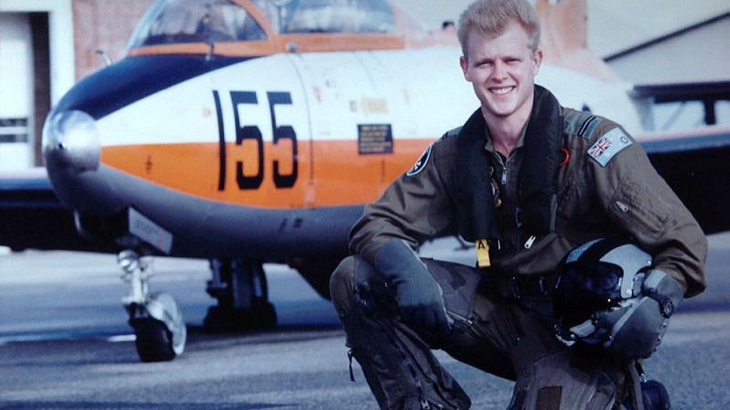A career with altitude

Fifty years ago, Squadron Leader Martin Copland was six years old and oblivious to the disaster about to unfold in his home town of Darwin.
CAPTION: Squadron Leader Martin Copland at the end of the 155 Pilot’s Course in 1991. It was the last course to use the Macchi jet. Story by Flying Officer Wendy Pyper.
Instead of celebrating Christmas, his family was among more than 30,000 people preparing to evacuate, after Cyclone Tracy razed the city.
“We sheltered at home until the eye passed overhead,” Squadron Leader Copland said.
“The house had some minor damage but my parents were worried about what might come next, so we drove to the cyclone shelter.
“When we returned, half the house was razed to the floorboards and my bedroom door was leaning against a pole, with my school bag still attached to the back of it.”
In the days after, young Martin was among more than 9600 people evacuated by RAAF aircraft, including the C-130A and E model Hercules operated by 36 Squadron and 37 Squadron respectively.
Twenty-five years later, as an Air Force pilot himself, Squadron Leader Copland flew the C-130E for 37 Squadron in its last year of service, before transitioning to the H model at 36 Squadron the following year.
“I don’t know which flight I was evacuated on in 1974, but there’s a 50 per cent chance I was in a C-130E and a seven in 12 chance I piloted the same aircraft,” he said.
The resilience and determination of Darwin’s residents, post-cyclone, are traits shared by Squadron Leader Copland that have enabled him to navigate the inevitable turbulence arising in an almost 40-year Air Force career.
His first bump came after high school.
“Towards the end of school I did work experience with 75 Squadron who were operating the Mirage in Darwin,” he said.
“I decided I wanted to be a pilot. I passed all the interviews, but I was told I was short-sighted.”
Instead, he signed up to a degree in aerospace engineering, joining Air Force in 1986 at the brand new ADFA in Canberra.
In his third year he decided to give pilot training another shot. Two ophthalmologist assessments later, his eyes were deemed fine.
“I completed the 155 Pilot’s Course at RAAF Base Pearce in 1991 and was in the last group to fly the Macchi MB-326 jet trainer, before it was replaced by the Pilatus PC-9/A,” Squadron Leader Copland said.
He went on to fly the HS 748 for 32 Squadron, the BBJ for 34 Squadron, qualified as a military paratrooper, and in 1998, spent 15 months as an Aide-de-Camp to Chief of Air Force.
“It was the year Air Marshal Errol McCormack changed the Air Force uniform from light blue to the old war-time colours that we wear now, and I was one of the first to model it,” Squadron Leader Copland said.
“I used to fly the Chief and his visiting parties around. He could fly too, so he’d often sit in the right-hand seat as my co-pilot, which was a bit daunting.”
In 2001 Squadron Leader Copland moved to 36 Squadron to fly the C-130H and take on “the best flying job I ever had”.
The posting took him on tactical operations, including Operation Slipper in Afghanistan, Operation Sumatra Assist after the 2004 Boxing Day tsunami, and to East Timor, Bougainville and the Solomon Islands.
CAPTION: Squadron Leader Martin Copland as a new doctor and intern at the Gosford Hospital Emergency Department in February 2016.
Then at age 44, Squadron Leader Copland joined a youthful cohort of post-graduates studying to become doctors.
It was another bumpy transition, but 12 years later, ‘Doc Martin’ is relishing his role as a contracted doctor to Defence at the Singleton Military Area, and a reservist medical officer with 2 Expeditionary Health Service.
“I wanted the prospect of professional mastery and I thought medicine would give me that opportunity for continuous improvement,” he said.
“As a pilot I was always changing aircraft or moving between different staff jobs, so I’d start at the bottom and work my way up each time.”
But he hasn’t left his pilot roots behind, with reserve stints providing medical support to exercises, including Pitch Black, Talisman Sabre and Diamond Storm, which draw on his experience in the air domain to inform patient care.
“Air Force invests a lot in its people, so the last thing you want is for them to have an accident because of a medical condition that wasn’t appropriately managed,” he said.
His reserve work often takes him back to the Northern Territory, where his interest in Air Force began.
“My father was a founding member of the Darwin Aviation Museum, so we spent camping trips looking for wrecked airplanes and discovering World War 2 aviation history,” he said.
“That’s where I developed an interest in Air Force history in the Top End.”
Today, Squadron Leader Copland is an indelible part of that history himself.
.
.

.
.






